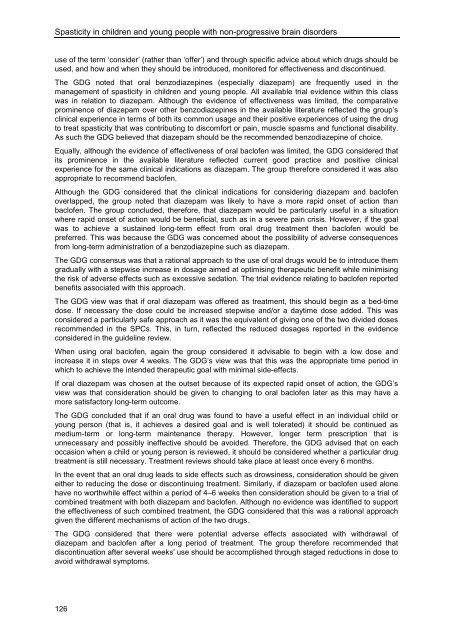National Collaborating Centre for Women's and Children's Health
National Collaborating Centre for Women's and Children's Health
National Collaborating Centre for Women's and Children's Health
You also want an ePaper? Increase the reach of your titles
YUMPU automatically turns print PDFs into web optimized ePapers that Google loves.
Spasticity in children <strong>and</strong> young people with non-progressive brain disorders<br />
use of the term ‘consider’ (rather than ‘offer’) <strong>and</strong> through specific advice about which drugs should be<br />
used, <strong>and</strong> how <strong>and</strong> when they should be introduced, monitored <strong>for</strong> effectiveness <strong>and</strong> discontinued.<br />
The GDG noted that oral benzodiazepines (especially diazepam) are frequently used in the<br />
management of spasticity in children <strong>and</strong> young people. All available trial evidence within this class<br />
was in relation to diazepam. Although the evidence of effectiveness was limited, the comparative<br />
prominence of diazepam over other benzodiazepines in the available literature reflected the group’s<br />
clinical experience in terms of both its common usage <strong>and</strong> their positive experiences of using the drug<br />
to treat spasticity that was contributing to discom<strong>for</strong>t or pain, muscle spasms <strong>and</strong> functional disability.<br />
As such the GDG believed that diazepam should be the recommended benzodiazepine of choice.<br />
Equally, although the evidence of effectiveness of oral baclofen was limited, the GDG considered that<br />
its prominence in the available literature reflected current good practice <strong>and</strong> positive clinical<br />
experience <strong>for</strong> the same clinical indications as diazepam. The group there<strong>for</strong>e considered it was also<br />
appropriate to recommend baclofen.<br />
Although the GDG considered that the clinical indications <strong>for</strong> considering diazepam <strong>and</strong> baclofen<br />
overlapped, the group noted that diazepam was likely to have a more rapid onset of action than<br />
baclofen. The group concluded, there<strong>for</strong>e, that diazepam would be particularly useful in a situation<br />
where rapid onset of action would be beneficial, such as in a severe pain crisis. However, if the goal<br />
was to achieve a sustained long-term effect from oral drug treatment then baclofen would be<br />
preferred. This was because the GDG was concerned about the possibility of adverse consequences<br />
from long-term administration of a benzodiazepine such as diazepam.<br />
The GDG consensus was that a rational approach to the use of oral drugs would be to introduce them<br />
gradually with a stepwise increase in dosage aimed at optimising therapeutic benefit while minimising<br />
the risk of adverse effects such as excessive sedation. The trial evidence relating to baclofen reported<br />
benefits associated with this approach.<br />
The GDG view was that if oral diazepam was offered as treatment, this should begin as a bed-time<br />
dose. If necessary the dose could be increased stepwise <strong>and</strong>/or a daytime dose added. This was<br />
considered a particularly safe approach as it was the equivalent of giving one of the two divided doses<br />
recommended in the SPCs. This, in turn, reflected the reduced dosages reported in the evidence<br />
considered in the guideline review.<br />
When using oral baclofen, again the group considered it advisable to begin with a low dose <strong>and</strong><br />
increase it in steps over 4 weeks. The GDG’s view was that this was the appropriate time period in<br />
which to achieve the intended therapeutic goal with minimal side-effects.<br />
If oral diazepam was chosen at the outset because of its expected rapid onset of action, the GDG’s<br />
view was that consideration should be given to changing to oral baclofen later as this may have a<br />
more satisfactory long-term outcome.<br />
The GDG concluded that if an oral drug was found to have a useful effect in an individual child or<br />
young person (that is, it achieves a desired goal <strong>and</strong> is well tolerated) it should be continued as<br />
medium-term or long-term maintenance therapy. However, longer term prescription that is<br />
unnecessary <strong>and</strong> possibly ineffective should be avoided. There<strong>for</strong>e, the GDG advised that on each<br />
occasion when a child or young person is reviewed, it should be considered whether a particular drug<br />
treatment is still necessary. Treatment reviews should take place at least once every 6 months.<br />
In the event that an oral drug leads to side effects such as drowsiness, consideration should be given<br />
either to reducing the dose or discontinuing treatment. Similarly, if diazepam or baclofen used alone<br />
have no worthwhile effect within a period of 4–6 weeks then consideration should be given to a trial of<br />
combined treatment with both diazepam <strong>and</strong> baclofen. Although no evidence was identified to support<br />
the effectiveness of such combined treatment, the GDG considered that this was a rational approach<br />
given the different mechanisms of action of the two drugs.<br />
The GDG considered that there were potential adverse effects associated with withdrawal of<br />
diazepam <strong>and</strong> baclofen after a long period of treatment. The group there<strong>for</strong>e recommended that<br />
discontinuation after several weeks' use should be accomplished through staged reductions in dose to<br />
avoid withdrawal symptoms.<br />
126

















